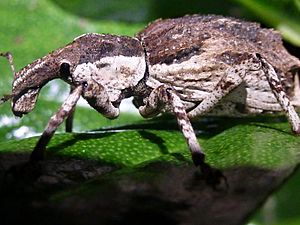Ngaio weevil facts for kids
Quick facts for kids Ngaio weevil |
|
|---|---|
 |
|
| Conservation status | |
 Nationally Critical (NZ TCS) |
|
| Scientific classification | |
| Genus: |
Anagotus
|
| Species: |
stephenensis
|
| Synonyms | |
|
|
The Anagotus stephenensis, commonly known as the ngaio weevil, is a large weevil that cannot fly. It is only found on Stephens Island in New Zealand.
This special weevil was first discovered in 1916 by A.C. O'Connor on Stephens Island. A scientist named Thomas Broun officially described it in 1921. He named it Phaeophanus oconnori after the person who found it. At that time, people saw these weevils eating tall grass and leaves from trees.
Contents
What the Ngaio Weevil Looks Like
This weevil is quite big and has a dark, hard outer shell, like armor. It's covered in tiny, coppery-brown hairs. Its sides and back are lighter, and it has a clear white stripe down the middle of its body (thorax). It also has noticeable bumps on its sides and back.
The ngaio weevil has a long snout, called a rostrum, which is as long as its body. This snout has a wide groove in the middle. From its snout to its tail, it measures about 23 to 27 millimeters. This weevil cannot fly and is active at night. It looks and is sized much like the Turbott's weevil, which is a close relative.
Where the Ngaio Weevil Lives
The ngaio weevil used to live in many places, even as far south as South Canterbury in New Zealand. Scientists found parts of their bodies, like wing covers and heads, in seven old cave deposits. These were left behind by the extinct laughing owl. This shows that the weevil was once common and spread out across the land.
Today, the ngaio weevil only lives in a small area on Stephens Island. This small group is what's left of its once wider population.
Ngaio Weevil's Home and Food
This weevil is known to live on ngaio trees (Myoporum laetum). It eats the leaves of these trees, leaving a special notch mark where it has chewed. Adult weevils have also been found on the karaka tree (Corynocarpus laevigatus).
Young weevils, called larvae, are thought to live inside the wood of these same trees. They bore into the stems, leaf bases, and roots. Other weevils from the same family often live inside living wood in a similar way.
Protecting the Ngaio Weevil
The ngaio weevil's conservation status was changed to "nationally critical" in 2012. This means it is in serious danger because there are very few of them left, and they are only found in one place.
When the weevils were first found in 1916, 15 specimens were collected. However, no specimens have been collected since 1971. A special search in 1995 only found one or two weevils over five nights. This shows that their numbers have gone down a lot since 1916.
One reason for this decline is likely the clearing of forests on Stephens Island. This happened when a lighthouse was built there in 1892, which reduced the weevil's habitat. It's also possible that an increase in the tuatara population might have affected the weevils. This happened after wild cats were removed from the island in 1925. It would be hard for a large, flightless, and nocturnal beetle to move between ngaio trees without being eaten by many tuatara.
The ngaio weevil is protected under a law called The 1953 Wildlife Act. This law makes it illegal to collect, own, or harm any ngaio weevil.

